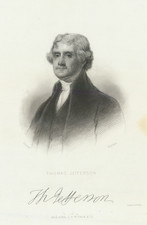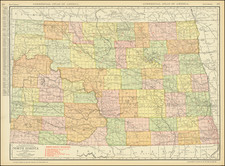Big Soldier. A Yankton Sioux Warrior by Bodmer
This nicely colored lithograph is a reduced version of the plate that originally appeared as Tableau 8 in the pictorial atlas of Prince Maximilian of Wied's famous travel account of the Western Plains. The present lithograph, by J. Honegger, was issued in 1845 at Zurich as plate no. 43 in H. R. Schinz’s Naturgeschichte und Abbildungen des Menschen.
Wahk-Tä-Ge-Li, a Yankton Sioux chief, whose name was translated by Prince Maximilian as Gallant or Valiant Warrior, was called Big Soldier by the Americans. Karl Bodmer originally painted the source watercolor of this lithograph at the Sioux agency located somewhere near modern-day Chamberlain, South Dakota, in May 1833. Big Soldier, a veteran six and a half foot warrior, strikes a dignified pose in his elaborately embroidered and colorful clothing. He gently holds a tomahawk in his right hand. His head is decorated with the long feathers of birds of prey. Various tokens of warpath exploits adorn his person, as well as a large silver medal issued by the United States government. Notably, this lithograph is reversed from the original watercolor and plate in the Maximilian atlas, both showing Big Soldier holding the tomahawk in his left hand.
Prince Maximilian described the making this portrait of Wahktägeli in his journals:
The chief appeared in full regalia ... hanging on his chest the medal he had received from the president of the United States ... His leather leggings, painted with dark transverse lines and crosses and very nicely adorned at the outer seam with a wide [strip] embroidered in porcupine quills with yellow, red, and sky-blue figures ... His buffalo robe was tanned white, and he held his tomahawk or battle-axe in his hand. He appeared to stand very willingly as a model for Mr. Bodmer, and remained the whole day in the position required, which, in general, the Indians find difficult to do.










![[ British Religious Prophetess Joanna Southcott ] A Medical Inspection or Miracles will Never Cease](https://storage.googleapis.com/raremaps/img/small/87382.jpg)
![[ Florida Indians - Destroying the Enemy's Towns By Night ] Hostium oppida noctu incendendi ratio. XXXI.er absagen](https://storage.googleapis.com/raremaps/img/small/97385.jpg)
![Gerardus Mercator . . . [and] . . . Iudocus Hondius . . .](https://storage.googleapis.com/raremaps/img/small/78439.jpg)

![(Early Computer Imaging) [A La Mémoire de J.M. Jacquard.]](https://storage.googleapis.com/raremaps/img/small/79513.jpg)